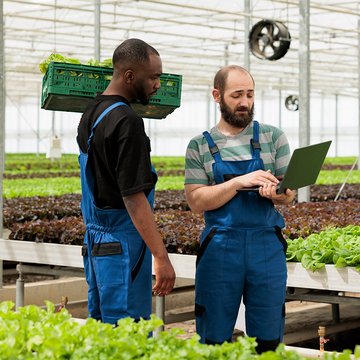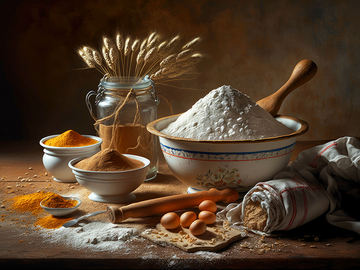Our Story
At Azures Carib, we take pride in being a premier provider of healthy gluten-free alternative flour, porridge, and waffle/pancake batter mixes!

Who We Are?
Azures Carib is a family-owned agro-processing company incorporated in Barbados.
Our purpose is to process and add value to the crops and products of the agricultural sector in the Caribbean. We are incorporated in Barbados and all our current manufacturing and packaging processes will be carried out on the island. We are also registered as an international Foreign Currency company. In effect, our processed products will be exported for sale especially in the wider Caribbean, North America and Europe.
The Caribbean is noted for its abundant agricultural products (e.g. fruits and ground
provisions). As noted earlier, our current competitive advantage is in our ability to refine our products to the highest standards required for international presence and competition. This is where Azures Carib comes in. We import and utilize the most cutting-edge manufacturing processes and technologies to package our produce. This way, our Caribbean-produced commodities will attract the full international market value which they deserve.
Come join our community!
Flours
These products are made by taking select Caribbean varieties of sweet potato or Cassava tubers, peeling and slicing them, then drying those slices. The dried product is then milled into a fine powder, sieved to a uniform particle size and packaged. The flours can be used in many applications in the kitchen, particularly for those desiring a gluten-free eating experience. So they can be used to thicken gravies and soups, to coat meats for frying, among other uses. Our flours are preserved by the process of drying, so there are no added chemical preservatives.


Porridge
Porridge historically was a staple food in much of Africa, Europe and Russia. It was primarily a savoury dish, with meats, root crops, vegetables and herbs added for flavour. Porridge is known throughout the world by several names – porridge, gruel, groats, stir-about, atole, grits, gachas, peasemeal, cream-of-wheat, and congee, among many other names. Porridge is also made from various crops, the main ones being – oats, barley, wheat, maize, rice, potato, and quinoa. In the Caribbean, we often use the term “Pap” and in addition to the crops listed, we can use root crops such as Sweet Potato or Cassava. So porridge is a world meal. The main reason for this is that it is so easily digested, and is relatively inexpensive.
Pancake/Waffle
The earliest forms of pancakes were made as early as the Stone Age, and were essentially different grains cooked on flat, hot stones. This later became flat cakes, toasted on both sides, and made from a cereal-based batter. Refinements were added over the centuries, most noticeably in Greece, then the Netherlands and Belgium, and then, with the inclusion of new spices from the new World, in the Americas. Along the way, Waffles were invented, as a sort of variant, especially in Belgium. The ancient Greeks and Romans ate pancakes, sweetened with honey; the Elizabethans ate them flavored with spices, rosewater, sherry, and apples. Ancient Greek poets Cratinus and Magnes wrote about pancakes in their poetry as did William Shakespeare. They were traditionally eaten in quantity on Shrove Tuesday or Pancake Day, a day of feasting and partying before the beginning of Lent. In the American colonies, pancakes—known as hoe cakes, johnnycakes, griddlecakes or flapjacks—were made with buckwheat or cornmeal. Thomas Jefferson was said to be very fond of pancakes and crepes. But pancakes are truly a global food. Many cultures seem to have a unique take on them. People eat them for breakfast, lunch, and dinner all over the world. Some examples of this transcultural food include crepes, potato latkes, Irish boxty, Russian blini, Welsh crampog, Indian poori and Hungarian palacsinta.
Today, Pancakes and Waffles come in many different shapes, sizes, and flavours. They can be sweet, savoury, thick, thin, small, or large, circular, square - but they are all delicious, when made from Azures Carib Pancake & Waffle Mix! You can add Banana, Strawberries, Mango, Papaya, Craisin and Granola, Blueberry, Apple and Pecan, or Cinnamon and Roasted Pecan served fresh with your favourite syrup. Over the years, Pancakes and Waffles have stood the test of time and now they hold a special place in our hearts, just like Azures Carib, reminding us of comfort, home, family and healthy meals

Our Ingredients
Cassava
Cassava (Manioc esculenta), also called Yuca or Manioc, is a starchy root vegetable that can be used similarly to potatoes. On the surface, this starchy tuber looks like a sweet potato or yam but with thicker skin. When cooked, cassava has a neutral flavour and soft, light texture. Cassava grows in tropical and subtropical climates. Evidence suggests it originated in Brazil then spread to Central America and the Caribbean. It later arrived in Southeast Asia and West Africa, where it still grows. In all of these regions, people have incorporated cassava into their cuisine.
Cassava roots should not be eaten raw. This is because raw Cassava contains cyanide, a poison. Cassava tubers are categorized as either bitter or sweet. The bitter varieties contain significant amounts of cyanide, but the sweet varieties, which are predominantly grown in the Caribbean, contain much lower levels. Note however that peeled, cooked cassava of any variety, is perfectly safe to eat. If you've ever followed a gluten-free or paleo diet, chances are you've come across recipes that call for cassava or cassava flour. One of the world's main sources of starch, cassava contains almost double the calories and carbohydrates as a potato. This makes it an excellent source of energy. In terms of nutrients, cassava contains small amounts of potassium, vitamin C, magnesium, and B vitamins.
Sweet Potato
The sweet potato (Ipomoea batatas) is a dicotyledonous herbaceous perennial vine that belongs to the morning glory family. Its large, starchy, sweet-tasting tuberous roots are used as a root vegetable. In some cultures, the young shoots and leaves are sometimes eaten as greens. Sweet potato is only distantly related to the common potato (Solanum tuberosum). Although darker sweet potatoes are often referred to as "yams" in parts of North America, the species is not a true yam (Dioscorea spp).
The sweet potato is native to the tropical regions of the Americas, but it is grown in Asia, Africa, and the Caribbean. The tubers can have various skin colours (white, yellow, red, purple), as well as flesh colours (white, yellow, orange, purple). Sweet potatoes are nutritious, packing a good amount of vitamin A, vitamin C, and manganese into each serving. They also have anticancer properties and may promote immune function and other health benefits. In addition, sweet potatoes — especially the orange and purple varieties — are rich in antioxidants that protect your body from free radicals. Free radicals are unstable molecules that can damage DNA and trigger inflammation. Free radical damage has been linked to chronic illnesses like cancer, heart disease, and aging. Therefore, eating antioxidant-rich foods is good for your health.
Flaxseeds
Azures Carib Porridge contains the nutrition powerhouse, Flaxseeds, which some call one of the most powerful plant foods on the planet. There’s some evidence it may help reduce the risk of heart disease, cancer, stroke, and diabetes. Although flaxseed contains all sorts of healthy components, it owes its primary healthy reputation to three of them
- Omega-3 essential fatty acids, "good" fats that have been shown to have heart-heaalthy effects. Each tablespoon of ground flaxseed contains about 1.8 grams of plant omega-3s.
- Lignans, which have both plant oestrogen and antioxidant qualities. Flaxseed contains 75 to 800 times more lignans than other plant foods.
- Fibre, flaxseed contains both soluble and insoluble fibre.
